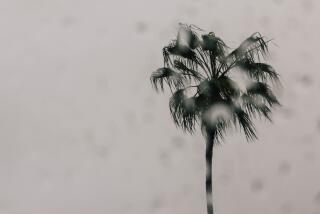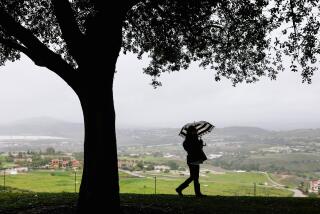Storm brings relief, but also triggers mudslides, floods and outages
Bill Golubics went to sleep fully clothed in his recliner in case the charred slope behind his house came down in the night.
The home next door on San Como Lane in Camarillo Springs was red-tagged in October and he knew his could be next.
The 77-year-old woke up about 2 a.m. when heavy rain began to drub his roof. He went out on the front porch to watch the deluge and then heard a boom. Within seconds, mud tore through his home and blew out the front window. He tried to get in to inspect, but debris had blocked his front door.
“I’ve never seen rain come down that hard for 30 minutes,” he said.
His home and nine others in the neighborhood were condemned as a fast-moving storm soaked Southern California on Friday morning. Streets flooded, slopes slid and electrical lines fell.
Rescue crews pulled a couple out of the surging Los Angeles River. A small tornado hopscotched over South Los Angeles, causing scattered damage. Drivers were stranded on Pacific Coast Highway. Neighborhoods in Azusa, Glendora, Camarillo and Silverado Canyon were evacuated. And across Southern California, 69,100 customers lost power.
Despite all the problems, the subtropical system brought relief to the state’s deeply depleted water system, dropping 3 to 5 inches of rain over Northern California — and up to 14 inches in some spots — and several feet of snow in the Sierra Nevada. Another storm is expected to roll off the Pacific early next week, followed by another system next weekend, forecasters say.
“We’re on the right trajectory, we just need to have this line continue with storms that keep bringing more rain,” said Doug Carlson, spokesman for the Department of Water Resources. “We don’t want the collateral damage of mudslides and home damage. But we have to take the bad with the good. That’s our attitude now.”
The Department of Water Resources measures precipitation at eight stations in the Northern Sierra to gauge how much water will flow into the state’s sprawling network of reservoirs and aqueducts. As of Friday, more than two months into the rain season, the stations had 18.3 inches of rainfall, 45% more than normal for this time of year. State hydrologists have said California would need about 75 inches of rain by the end of the season, Sept. 30, to declare the drought over.
William Patzert, climatologist for the Jet Propulsion Laboratory, said that although this storm did some damage, it cleared out quickly. He said for perspective, consider December 2010, when 10.23 inches of rain fell between Dec. 16 and Dec. 29, causing massive flooding. And for those who think early rains are a sign of a wet winter, after those 2010 rains, Southern California went dry.
Patzert said the greatest upside of the recent storms came in the Sierra, where Southern California gets much of its water.
“They’re definitely getting snow. The snow season for a change got off to a fast start,” he said. “That’s probably the biggest thing regarding drought relief.”
Drought was less on the minds of those threatened by the flooding and mudslides that such fast storms often produce.
About 2 a.m., Branduinn Fullove, 34, was driving north on Pacific Coast Highway near Sycamore Canyon north of Malibu when a concrete barrier that had been against the hillside plunged into his lane.
A torrent of mud, furniture-size rocks and tree stumps spewed over it, shoving his Honda Accord toward the ocean.
“I just thought for sure I was going over the edge,” he said.
He hit his brakes and tried to turn, but the wheels slid with the mud beneath them.
He said he prayed. When the car came to rest in the dark, he stepped out to see he was a few feet from going over the rock embankment into the ocean.
“I’m really excited to be alive right now,” Fullove said, recounting the incident at a Ventura County fire station later in the morning.
There were three separate mudslides on PCH where it skirts the Santa Monica Mountains, stranding at least seven people.
One man was taken to a hospital with hypothermia after his Mustang got trapped, officials said.
Just north of downtown Los Angeles, rescue teams from the Fire Department pulled a couple from the Los Angeles River near Glendale Boulevard.
The couple, transients living along the river, became trapped as the fast-moving current rose around them, according to authorities.
The man was located and rescued first, and told rescue swimmers that his wife was still in the water.
Crews searched for more than an hour amid the tangle of arundo cane, willows and cottonwoods as water rushed through. People on the banks could hear her, but no one could see her. A Fire Department helicopter made low passes, churning spray on the spectators
Finally she was spotted amid the trees, and a rescue swimmer reached her. She appeared to be hypothermic in a soaked T-shirt. The rescuer put a life jacket on the woman and pulled her to the bank in a rubber raft.
One of the rescuers, Dusty Clark, said the woman seemed thankful but was “unable to communicate.”
Paramedics took the couple to local hospitals. Their identities were not released.
LAFD Battalion Chief Charles Butler said that many homeless people live along the river in that area — and that whenever it rains there is a danger of someone getting caught in the water.
“It’s a big issue for us down here,” Butler said. “The river’s beautiful, with the trees in the middle. . . . but it really creates a great deal of risk for our firefighters.”
Butler said the trees are called a “strainer” by swift water rescuers — a deadly hazard that lets water pass through but traps a person.
“If you get hung up in a strainer, you’re likely going to drown,” he said.
To the south, a small tornado touched down in South Los Angeles shortly after 9:20 a.m. and hopped along over a 10-block area from Gage and Vermont avenues to 57th Street and South Figueroa Street, said Eric Boldt, a meteorologist with the National Weather Service. It damaged at least five homes, tearing off one roof. Deborah LaVergne, 56, was preparing turkey sandwiches in the kitchen of the Garr Learning Center when she looked out the window and saw a black trash can twirl 30 feet in the air. “The whole building was shaking,” LaVergne said.
To the east, in one of the biggest hazard areas, residents escaped mostly unscathed.
Officials evacuated residents in Azusa and Glendora below the footprint of the Colby fire, which burned 1,700 acres of extremely steep hillsides in January.
Getting ready to leave his house on Ridge View Drive in Azusa about 7 a.m., Edward Heinlein, 66, pointed to a deep mass of mud that crept across his backyard at night.
“That’s the monster,” he said.
It had engulfed tree trunks. A regulation basketball hoop was low enough for his adult daughter to grab the rim. Heinlein was ready to go to his son’s house until the evacuation orders were lifted. Luckily for him, the rain tapered off in a few hours and the monster stood still, waiting until the next storm.
amanda.covarrubias@latimes.com
Times staff writers Cindy Chang, Matt Hamilton, Samantha Masunaga, Veronica Rocha, Joseph Serna, Matt Stevens and Ruben Vives contributed to this report.
More to Read
Start your day right
Sign up for Essential California for news, features and recommendations from the L.A. Times and beyond in your inbox six days a week.
You may occasionally receive promotional content from the Los Angeles Times.









